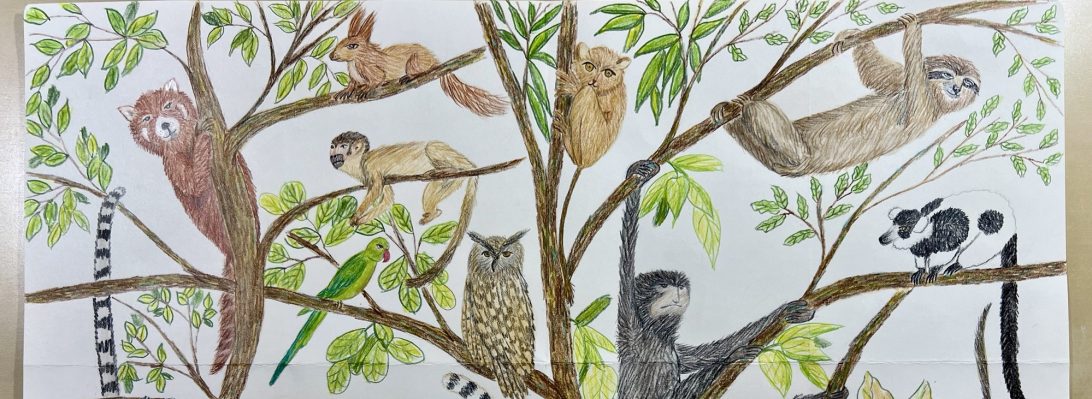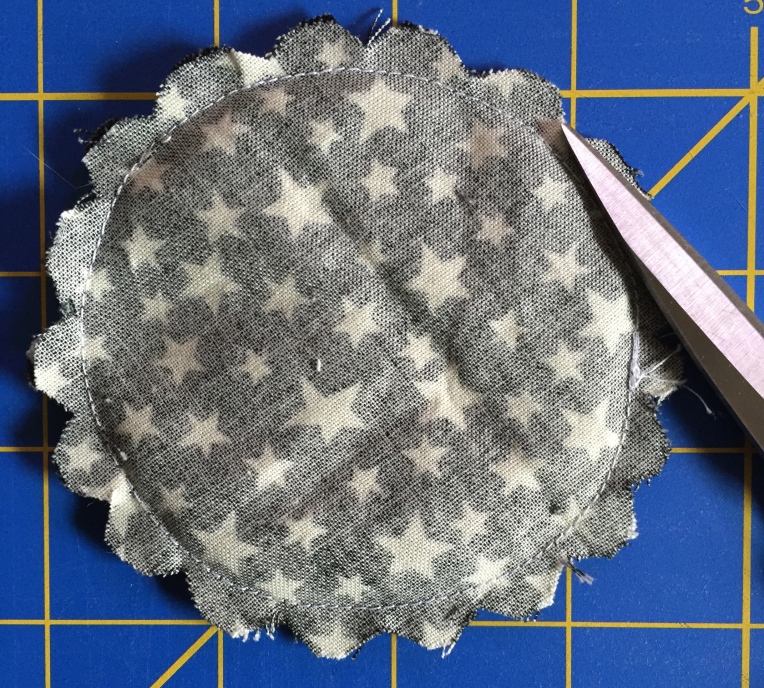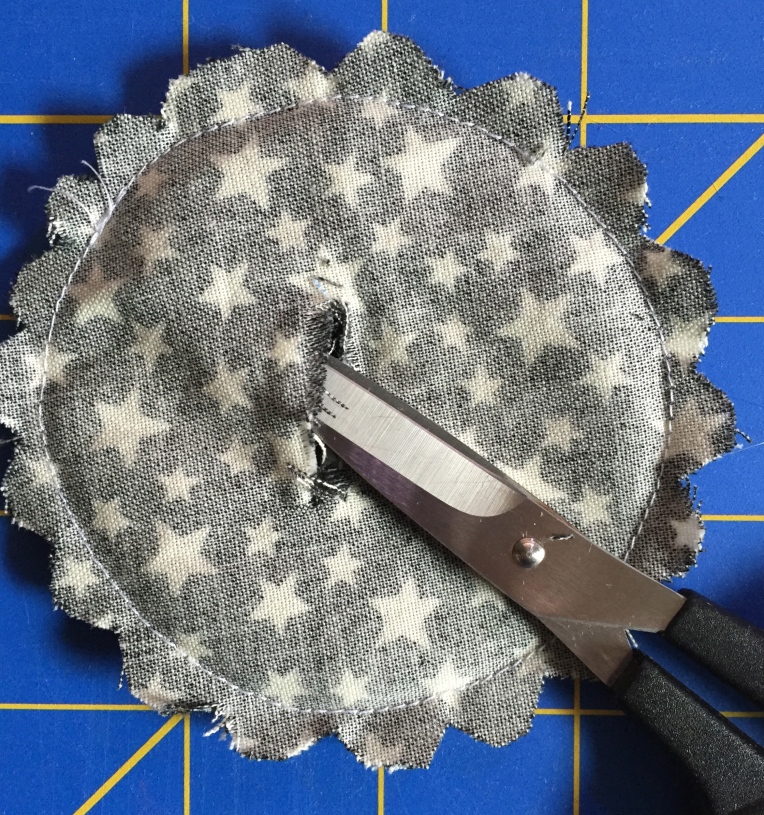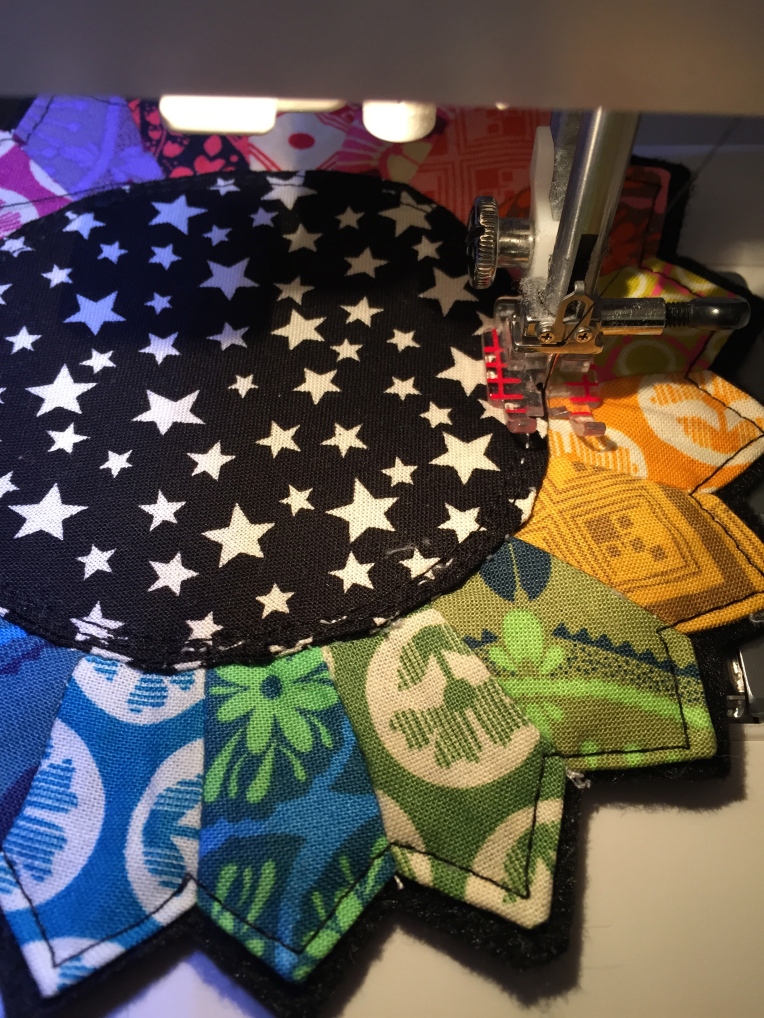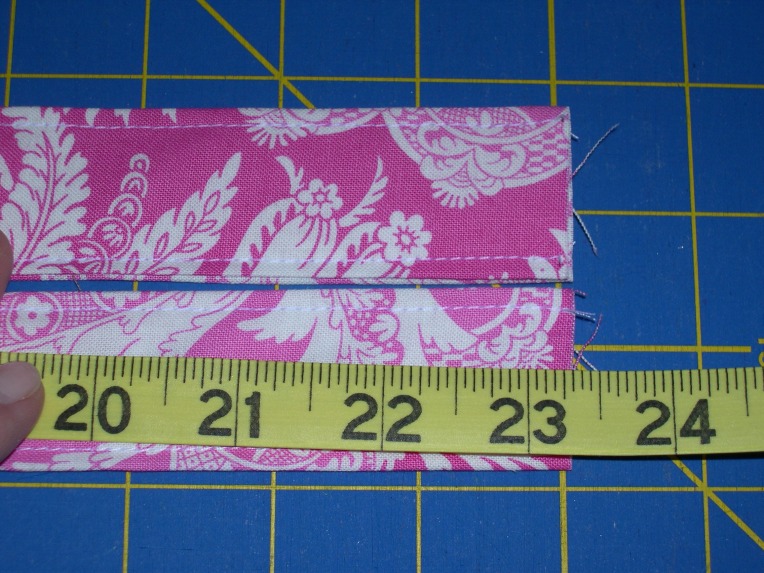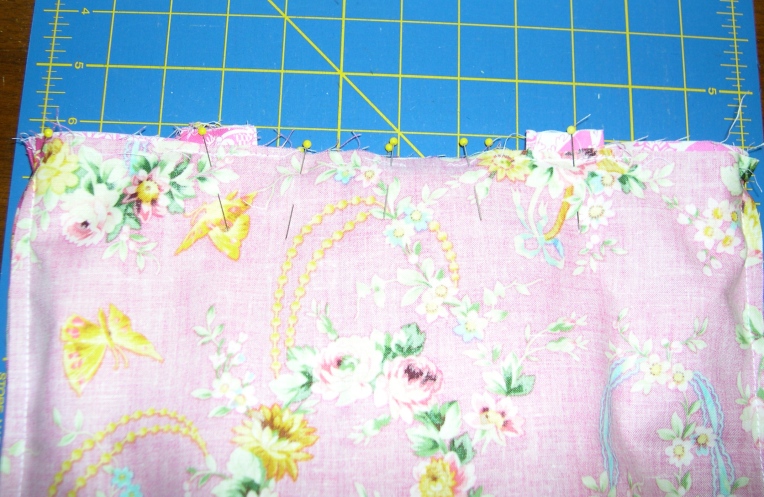What girl wouldn’t want to carry such a pretty makeup bag? Would you like to learn how to make this so you can carry one yourself or give it to your bestest friend for a gift?

This particular bag has a little secret – fusible vinyl on the inside! That is my little twist on this common bag, so I will show you how to do it.

Supplies:
Fat quarter for outside – I used a cute toile print by Jennifer Paganelli.
Fat quarter for lining
Batting or interfacing
Fusible Vinyl – I used Therm-O-Web Iron-On Vinyl (from Joann’s)
7-inch zipper
Usual sewing tools (ruler, rotary, thread, iron)
Note: use a 1/4 inch seam allowance throughout this project.
Cutting:
1. Cut out your outside and lining fabric 9-1/2 inches wide x 5-1/2 inches tall.
Cut out your batting or interfacing 9-1/2 inches wide x 5-1/2 inches tall.
Cut out two pieces of fusible vinyl 9-1/2 inches wide x 5-1/2 inches tall.
Cut two pieces of either fabric 2.5 inches wide x 2.5 inches long or 2.5 inches x 3 inches long. (Feel free to use scraps for this step because the ends are going to get trimmed and buried in the seam allowance.)

Preparing the Pieces:
1. Position your outside fabric over the batting (or interfacing) and quilt. I did a grid of diagonal lines for this sample. My grid lines were a little over 1 inch apart. I also used a guide bar, which you can see in the photo below (positioned behind the needle and foot), to help keep the lines straight and even.

2. Make the same grid on the back piece.
 3. To fuse the vinyl to the right side of the lining fabric, peel off the paper backing of the vinyl. Position the vinyl sticky-side down over the RIGHT side of the lining fabric and press with your hand to smooth it out. Place that paper backing shiny side down on the vinyl and hold your iron over the area for a few second. Continue until the entire area is laminated. Turn fabric right side up and press each area again, just for good measure. (you can also follow the directions that come with the fusible vinyl)
3. To fuse the vinyl to the right side of the lining fabric, peel off the paper backing of the vinyl. Position the vinyl sticky-side down over the RIGHT side of the lining fabric and press with your hand to smooth it out. Place that paper backing shiny side down on the vinyl and hold your iron over the area for a few second. Continue until the entire area is laminated. Turn fabric right side up and press each area again, just for good measure. (you can also follow the directions that come with the fusible vinyl)
 4. Take one fabric tab and fold the short end over about 1/4 to 1/2 inch. (use your judgment here in the amount you fold over, depending on the size of scrap you’re using.)
4. Take one fabric tab and fold the short end over about 1/4 to 1/2 inch. (use your judgment here in the amount you fold over, depending on the size of scrap you’re using.)
 Now, fold in half the long way to create a sort of pocket.
Now, fold in half the long way to create a sort of pocket.

Insert one zipper end into tab so the fold meets with the end of the zipper teeth. Top stitch close to fold to attach to end of zipper. Repeat for other side of zipper. (At this point, don’t worry about any long excess fabric on these tabs. They will get buried in the seam allowance and trimmed to reduce bulk.)

Bag Assembly Instructions:
1. Fold outside front piece in half to find the center. Fold the zipper in half to find the center. With zipper pull on left side and face down, position zipper over right side of front fabric, using those fold creases to center it, and pin.
 Put a zipper foot in your sewing machine and stitch zipper onto front fabric.
Put a zipper foot in your sewing machine and stitch zipper onto front fabric.
 2. Position this piece-in-progress face down over one of a fused lining piece, which should be right side up. Pin in the seam allowance (so your pin holes are hidden in the seam allowance), and sew along that stitching line. At this point, everything will feel quite slippery because of that vinyl. Just hold the pieces together and go slowly to keep an even stitching line and keep the raw edges lined up.
2. Position this piece-in-progress face down over one of a fused lining piece, which should be right side up. Pin in the seam allowance (so your pin holes are hidden in the seam allowance), and sew along that stitching line. At this point, everything will feel quite slippery because of that vinyl. Just hold the pieces together and go slowly to keep an even stitching line and keep the raw edges lined up.
 3. Snip off the excess fabric from the tabs. At this point, here is what your piece-in-progress looks like when you open it up.
3. Snip off the excess fabric from the tabs. At this point, here is what your piece-in-progress looks like when you open it up.
 4. Position your piece-in-progress over the back fabric with the outside fabrics facing each other. (zipper will be face down) Pin and stitch.
4. Position your piece-in-progress over the back fabric with the outside fabrics facing each other. (zipper will be face down) Pin and stitch.
 5. Align your piece-in-progress over the final lining piece with the lining fabrics facing each other, pin in the seam allowance, and stitch. This is what your piece-in-progress should look like now, with all four pieces sewn to the zipper.
5. Align your piece-in-progress over the final lining piece with the lining fabrics facing each other, pin in the seam allowance, and stitch. This is what your piece-in-progress should look like now, with all four pieces sewn to the zipper.
 Here’s the lining side. (I couldn’t resist adding one of my new labels printed by Spoonflower!)
Here’s the lining side. (I couldn’t resist adding one of my new labels printed by Spoonflower!)
 6. Open your zipper all the way. This is very important so you can turn the bag right side out and through the zipper opening when you’re all done with the assembly.
6. Open your zipper all the way. This is very important so you can turn the bag right side out and through the zipper opening when you’re all done with the assembly.
7. Lay out your piece-in-progress so that the outside fabrics are right sides together, and your lining fabrics are right sides together. Pin in the seam allowances, leaving a space in the bottom center of the lining. That is where you’re going to leave a hole for turning the bag inside out.
 8. Stitch all the way around the bag, starting at the bottom center of the lining, and ending about 3 inches from your starting point (so you have an opening in the bottom).
8. Stitch all the way around the bag, starting at the bottom center of the lining, and ending about 3 inches from your starting point (so you have an opening in the bottom).
 Making a Flat Bottom:
Making a Flat Bottom:
1. To prepare the corners for a flat bottom, pinch a corner so the seams line up, making the corner look like a triangle. Measure 3/4 inch from one side of the triangle, and draw a line all the way across. Stitch on that line, which will give you a 1.5 inch bottom.
 2. Snip off the corner, leaving a 1/4 inch seam allowance.
2. Snip off the corner, leaving a 1/4 inch seam allowance.

Repeat for the remaining three corners of your bag.

The Home Stretch!
Turn your bag right side out through the opening you left on the bottom of the lining and through the zipper you left open.
 Hand stitch the opening closed. Fill with your goodies!
Hand stitch the opening closed. Fill with your goodies!
That’s it! Easy, right? I hope these instructions are helpful, and I hope you try making at least one of these fun little zipper bags! I would love to see a picture of your version.
If you’re interested in printing out this tutorial without using a lot of toner, I made a PDF with just the step-by-step instructions and one photo for reference.
Please don’t make this bag to resell, whether in your shop, at your local craft fair, or any other place.

Edit: Here’s a little plug for my shop to let you know I added this makeup bag and another pretty pink toile bag to the New Products section of my shop, in case you need a cute little gift but don’t have the time to make one yourself. I’m always happy to take a custom order too!
 Lay each wedge right side together, and stitch all the wedges together to form a ring, using a 1/4″ seam allowance. Press seams open.
Lay each wedge right side together, and stitch all the wedges together to form a ring, using a 1/4″ seam allowance. Press seams open. Measure the inner circle and add 1/2″ to 3/4″ to each side for the seam allowance. Cut a circle from paper or plastic to use as a template; cut 2 circles from your center fabric.
Measure the inner circle and add 1/2″ to 3/4″ to each side for the seam allowance. Cut a circle from paper or plastic to use as a template; cut 2 circles from your center fabric.
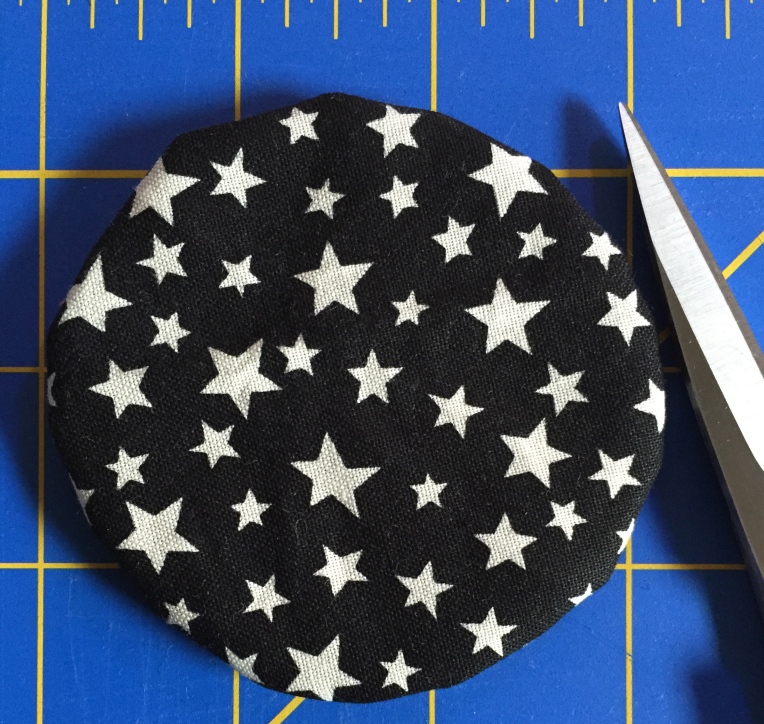 Lay the fabric circles on top of dresden ring, pin if necessary, and top-stitch to attach to ring of the wedges. I top-stitched twice to make sure it was secure.
Lay the fabric circles on top of dresden ring, pin if necessary, and top-stitch to attach to ring of the wedges. I top-stitched twice to make sure it was secure.